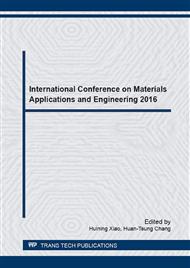p.3
p.8
p.13
p.18
p.23
p.28
p.33
p.38
Defect Stability and Electronic Configuration of Off-Stoichiometric Ni-X-In (X = Mn, Fe and Co) Alloys: A First-Principles Study
Abstract:
Ni-Mn-In is a novel type of magnetic shape memory alloy, its shape memory effect has been realized through magnetic field induced reverse martensitic transformation. A variety of point defects would be generated during composition adjustment process, such as antisite defect, vacancy and exchange. The first–principles calculations within the framework of the density functional theory using the Vienna ab initio software package (VASP) have been used in this paper to investigate the defect formation energy and electronic configuration of the off-stoichiometric Ni-X-In (X= Mn, Fe and Co) alloys. The In antisite on the X sublattice (InX) and the Ni antisite on the X sublattice (NiX) have the lowest formation energies in the investigated series. The formation energy of the Ni vacancy is the lowest, while that of the in vacancy is the highest. It is confirmed that the in constituent plays a dominant role for stabilizing the austenitic phase.
Info:
Periodical:
Pages:
8-12
Citation:
Online since:
September 2016
Authors:
Price:
Сopyright:
© 2016 Trans Tech Publications Ltd. All Rights Reserved
Share:
Citation:


